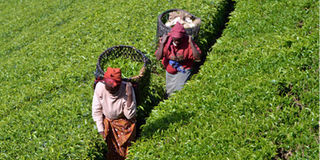Tea earnings to hit Sh110bn

PHOTO | JOSEPH KANYI Two women carry tea leaves from a farm to a selling centre at Kihome village in Othaya on September 28, 2012.
What you need to know:
- Tea production is expected to decline by 5 per cent to 360 million bags against 377 million bags registered last year, owing to frost experienced in parts of the country this year. Exports are also expected to decline by the same margin
- Briefing the media on the performance of the sector for the period January to August, Tea Board of Kenya managing director Sicily Kariuki said international prices had increased, with a kilogramme of Kenya-made tea selling at an average price of $3.15 (about Sh268), compared with $3.02 (Sh255) last year
- Ms Kariuki said growth was witnessed in traditional markets in Egypt and Pakistan, and other emerging markets like United Arab Emirates, Russia, Somalia, Iran, Djibouti, USA and Turkey
Export earnings from tea are expected to increase by 1 per cent to Sh110 billion, compared with Sh109 billion last year, on account of high international prices.
But tea production is expected to decline by 5 per cent to 360 million bags against 377 million bags registered last year, owing to frost experienced in parts of the country this year. Exports are also expected to decline by the same margin.
Briefing the media on the performance of the sector for the period January to August, Tea Board of Kenya managing director Sicily Kariuki said international prices had increased, with a kilogramme of Kenya-made tea selling at an average price of $3.15 (about Sh268), compared with $3.02 (Sh255) last year.
Prices have been rising from $2.91 (Sh247) in January, maintaining a stable price of $3.42 (Sh290) per kilo in the months of July and August.
Global auction average prices at Mombasa (for regional teas) were $2.82 (Sh242), Colombo $2.98 (Sh253) and Calcutta $2.63 (Sh223).
“Tea prices have been firm in all major tea auction centres, which is attributed to lower tea production. Major producers like China, India and Sri Lanka are importing Kenya tea, some of which is used to blend their teas” she said.
Ms Kariuki said growth was witnessed in traditional markets in Egypt and Pakistan, and other emerging markets like United Arab Emirates, Russia, Somalia, Iran, Djibouti, USA and Turkey.
Overall, Kenya exported tea to 53 destinations, compared with 50 in 2011.
She said that political stability in the Middle East, enhanced promotion and increased imports from traditional producers like China and India were some of the factors responsible for increased demand.
Others were diversified use of tea in pharmaceutical industries and speciality tea segment. These helped to increase demand and push up prices.
“The supply and demand gap is closing and is expected to continue until 2020 as more uses for tea are discovered,” Ms Kariuki said. Domestic consumption declined by 5.67 per cent, which was attributed to higher prices and competition from other beverages.



